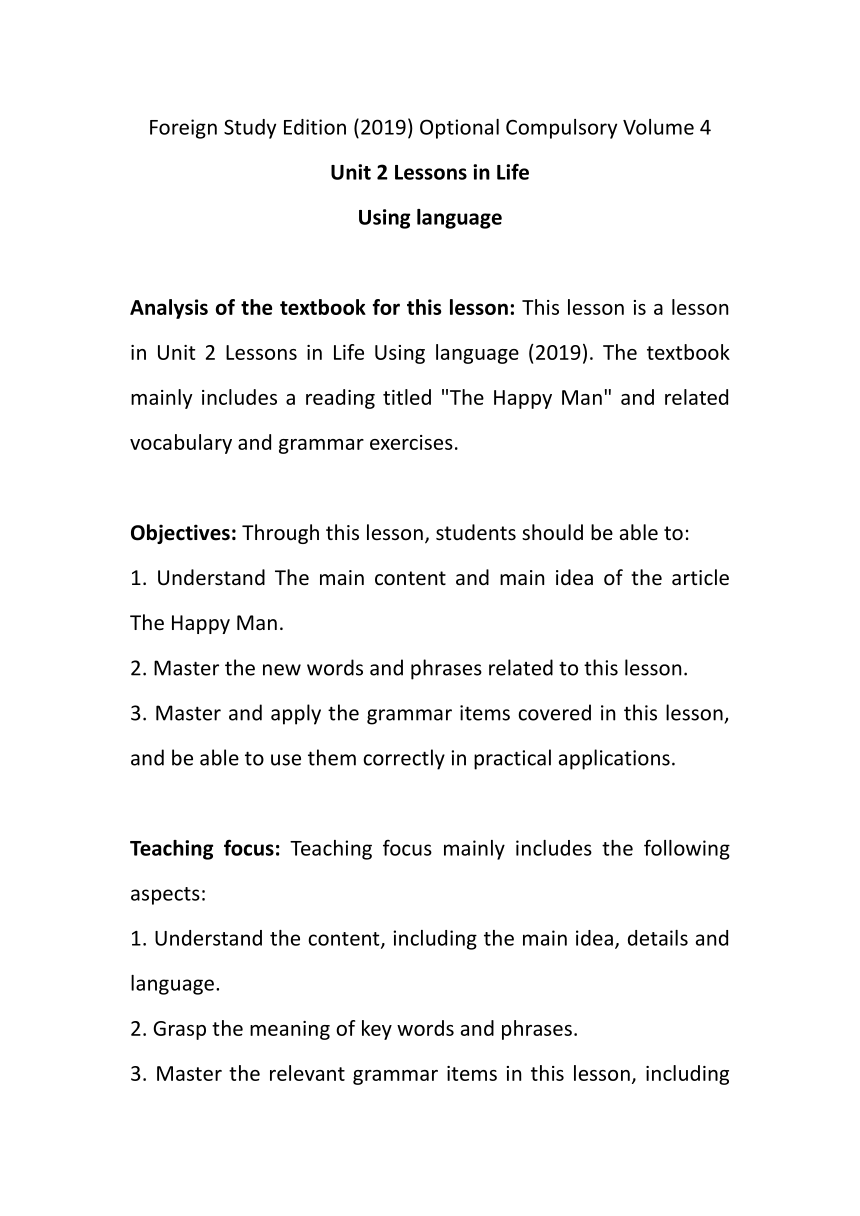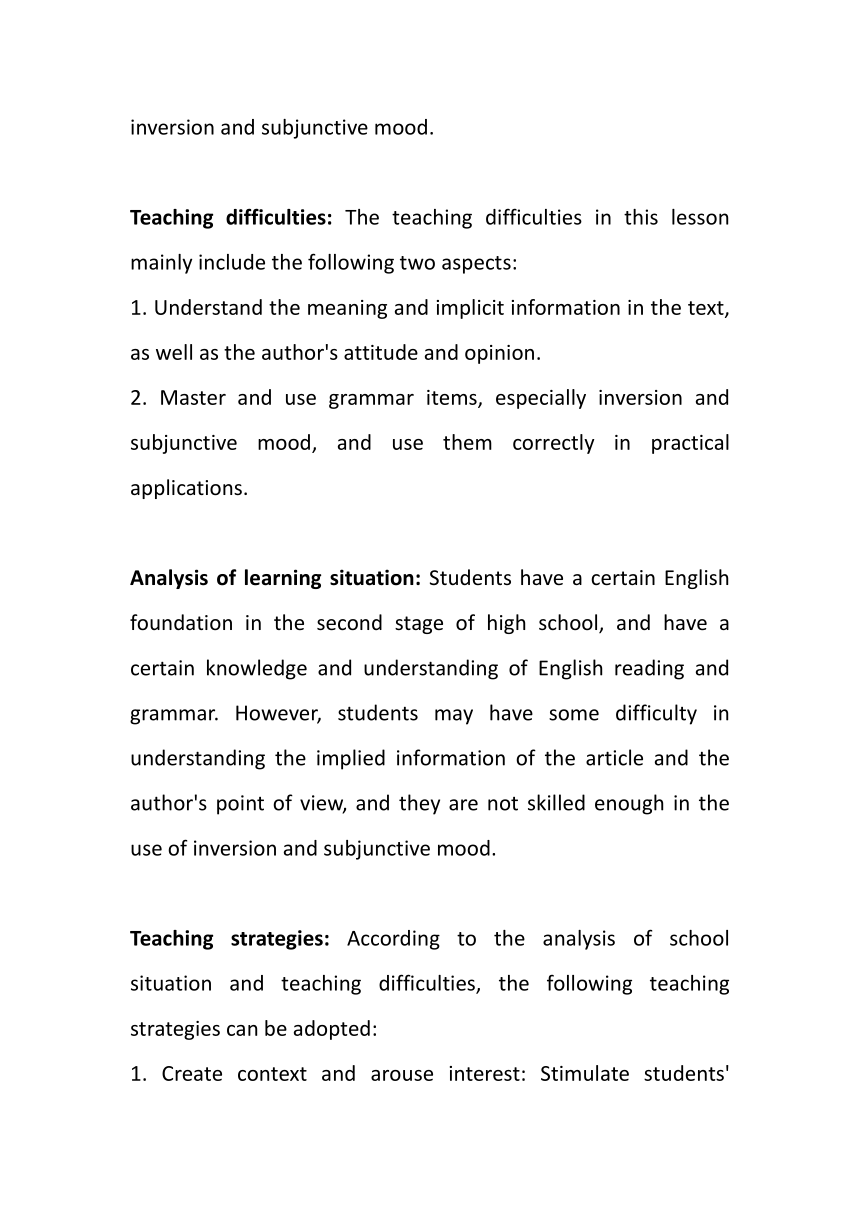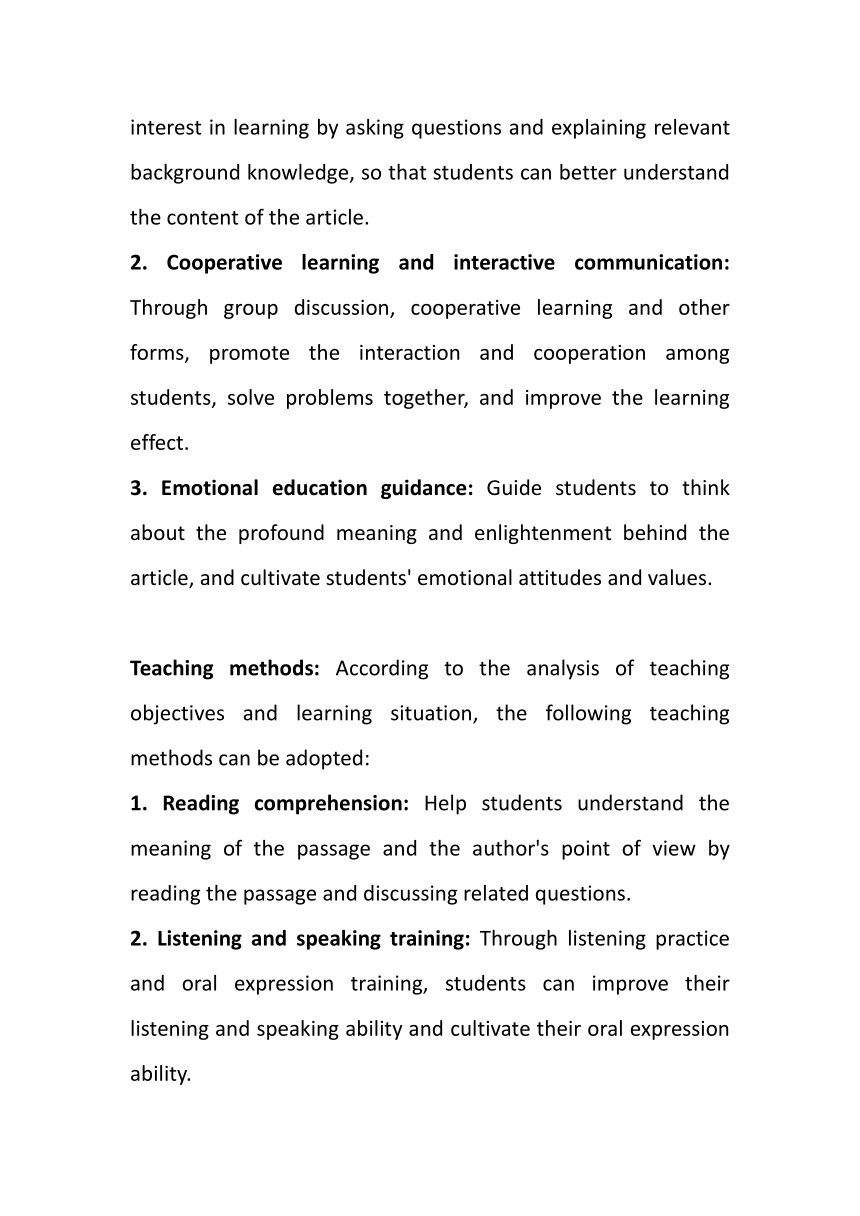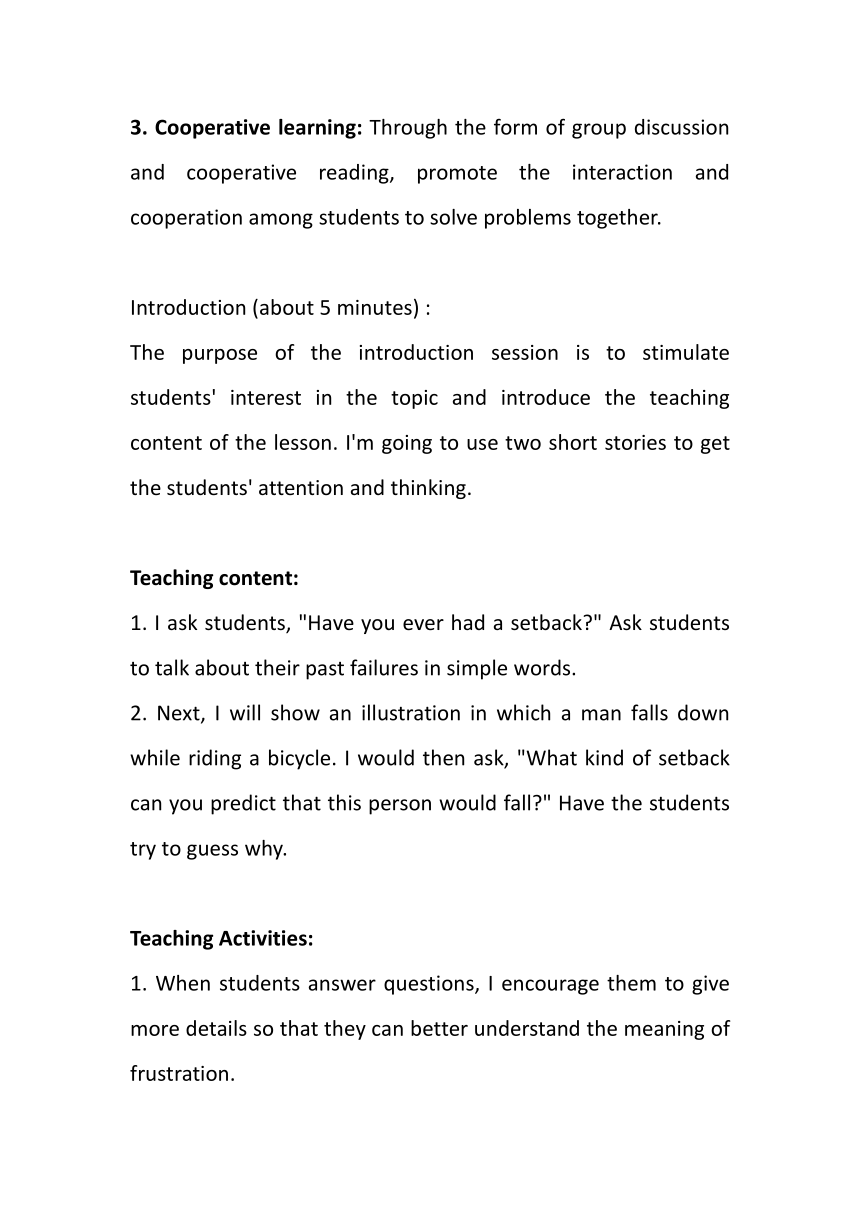外研版(2019)选择性必修第四册Unit 2 Lessons in Life Using Language 教学设计
文档属性
| 名称 | 外研版(2019)选择性必修第四册Unit 2 Lessons in Life Using Language 教学设计 |  | |
| 格式 | docx | ||
| 文件大小 | 14.5KB | ||
| 资源类型 | 教案 | ||
| 版本资源 | 外研版(2019) | ||
| 科目 | 英语 | ||
| 更新时间 | 2024-05-06 11:38:19 | ||
图片预览




文档简介
Foreign Study Edition (2019) Optional Compulsory Volume 4 Unit 2 Lessons in Life
Using language
Analysis of the textbook for this lesson: This lesson is a lesson in Unit 2 Lessons in Life Using language (2019). The textbook mainly includes a reading titled "The Happy Man" and related vocabulary and grammar exercises.
Objectives: Through this lesson, students should be able to:
1. Understand The main content and main idea of the article The Happy Man.
2. Master the new words and phrases related to this lesson.
3. Master and apply the grammar items covered in this lesson, and be able to use them correctly in practical applications.
Teaching focus: Teaching focus mainly includes the following aspects:
1. Understand the content, including the main idea, details and language.
2. Grasp the meaning of key words and phrases.
3. Master the relevant grammar items in this lesson, including inversion and subjunctive mood.
Teaching difficulties: The teaching difficulties in this lesson mainly include the following two aspects:
1. Understand the meaning and implicit information in the text, as well as the author's attitude and opinion.
2. Master and use grammar items, especially inversion and subjunctive mood, and use them correctly in practical applications.
Analysis of learning situation: Students have a certain English foundation in the second stage of high school, and have a certain knowledge and understanding of English reading and grammar. However, students may have some difficulty in understanding the implied information of the article and the author's point of view, and they are not skilled enough in the use of inversion and subjunctive mood.
Teaching strategies: According to the analysis of school situation and teaching difficulties, the following teaching strategies can be adopted:
1. Create context and arouse interest: Stimulate students' interest in learning by asking questions and explaining relevant background knowledge, so that students can better understand the content of the article.
2. Cooperative learning and interactive communication: Through group discussion, cooperative learning and other forms, promote the interaction and cooperation among students, solve problems together, and improve the learning effect.
3. Emotional education guidance: Guide students to think about the profound meaning and enlightenment behind the article, and cultivate students' emotional attitudes and values.
Teaching methods: According to the analysis of teaching objectives and learning situation, the following teaching methods can be adopted:
1. Reading comprehension: Help students understand the meaning of the passage and the author's point of view by reading the passage and discussing related questions.
2. Listening and speaking training: Through listening practice and oral expression training, students can improve their listening and speaking ability and cultivate their oral expression ability.
3. Cooperative learning: Through the form of group discussion and cooperative reading, promote the interaction and cooperation among students to solve problems together.
Introduction (about 5 minutes) :
The purpose of the introduction session is to stimulate students' interest in the topic and introduce the teaching content of the lesson. I'm going to use two short stories to get the students' attention and thinking.
Teaching content:
1. I ask students, "Have you ever had a setback " Ask students to talk about their past failures in simple words.
2. Next, I will show an illustration in which a man falls down while riding a bicycle. I would then ask, "What kind of setback can you predict that this person would fall " Have the students try to guess why.
Teaching Activities:
1. When students answer questions, I encourage them to give more details so that they can better understand the meaning of frustration.
2. Then, I would have the students watch a short video in which the protagonist, after experiencing a huge setback, picked himself up and finally succeeded. By watching this video, I hope students can understand that setbacks are part of success.
Classroom interaction (approx. 35 minutes) :
Classroom interaction is the core of the whole classroom teaching. I will help students improve their English ability and understand the content of the textbook by involving them in various teaching activities.
Teaching content:
1. I would hand out relevant reading materials from the textbook and ask students to read and mark key words independently, and then discuss their understanding with their deskmates.
2. Next, I will organize students to share in groups and let each group show their understanding and discussion results. I also encourage students to ask questions and answer them.
Teaching Activities:
1. In group sharing, I will give students a certain degree of freedom, so that they can show their ideas and opinions, and cultivate their expression ability and team spirit.
2. I encourage students to share their opinions, orally or in writing, and provide appropriate feedback and guidance.
End session (approx. 5 minutes) :
The purpose of the end is to review the teaching content of this lesson, consolidate students' knowledge points, and summarize students' learning.
Teaching content:
1. I ask the students, "What did we learn in this lesson " Ask students to answer important points about setbacks and success.
Teaching Activities:
1. I will encourage students to take the initiative to answer questions and share what they have learned and experienced in this class.
2. Finally, I will affirm and praise the students' performance, and remind them to face setbacks and strive for success in their future study.
Teaching reflection:
In the teaching of this lesson, students have a good understanding and memory of the text content, and can basically master the main content and details of the text. However, on reflection, I found that there are still the following problems:
1. For a diverse group of students, the difficulty of the questions can be more stratified. For students with a good grasp, we can add some expanding questions to improve students' thinking ability.
2. In terms of topic design, some open thinking questions can be added to encourage students to think and express deeply, and cultivate their critical thinking ability.
3. In the teaching process, more multimedia and interactive teaching means should be used to stimulate students' interest in learning and improve their participation. At the same time, it can also be combined with some real cases or stories, so that students can better understand and apply the knowledge in the text.
Through the teaching experience of this class, I have deeply realized that teaching is a process of continuous improvement and promotion. In the future teaching, I will design more diversified and differentiated topics, pay attention to the development of students' thinking and ability training, and make full use of various teaching resources and means to improve the teaching effect and stimulate students' learning interest and motivation.
Using language
Analysis of the textbook for this lesson: This lesson is a lesson in Unit 2 Lessons in Life Using language (2019). The textbook mainly includes a reading titled "The Happy Man" and related vocabulary and grammar exercises.
Objectives: Through this lesson, students should be able to:
1. Understand The main content and main idea of the article The Happy Man.
2. Master the new words and phrases related to this lesson.
3. Master and apply the grammar items covered in this lesson, and be able to use them correctly in practical applications.
Teaching focus: Teaching focus mainly includes the following aspects:
1. Understand the content, including the main idea, details and language.
2. Grasp the meaning of key words and phrases.
3. Master the relevant grammar items in this lesson, including inversion and subjunctive mood.
Teaching difficulties: The teaching difficulties in this lesson mainly include the following two aspects:
1. Understand the meaning and implicit information in the text, as well as the author's attitude and opinion.
2. Master and use grammar items, especially inversion and subjunctive mood, and use them correctly in practical applications.
Analysis of learning situation: Students have a certain English foundation in the second stage of high school, and have a certain knowledge and understanding of English reading and grammar. However, students may have some difficulty in understanding the implied information of the article and the author's point of view, and they are not skilled enough in the use of inversion and subjunctive mood.
Teaching strategies: According to the analysis of school situation and teaching difficulties, the following teaching strategies can be adopted:
1. Create context and arouse interest: Stimulate students' interest in learning by asking questions and explaining relevant background knowledge, so that students can better understand the content of the article.
2. Cooperative learning and interactive communication: Through group discussion, cooperative learning and other forms, promote the interaction and cooperation among students, solve problems together, and improve the learning effect.
3. Emotional education guidance: Guide students to think about the profound meaning and enlightenment behind the article, and cultivate students' emotional attitudes and values.
Teaching methods: According to the analysis of teaching objectives and learning situation, the following teaching methods can be adopted:
1. Reading comprehension: Help students understand the meaning of the passage and the author's point of view by reading the passage and discussing related questions.
2. Listening and speaking training: Through listening practice and oral expression training, students can improve their listening and speaking ability and cultivate their oral expression ability.
3. Cooperative learning: Through the form of group discussion and cooperative reading, promote the interaction and cooperation among students to solve problems together.
Introduction (about 5 minutes) :
The purpose of the introduction session is to stimulate students' interest in the topic and introduce the teaching content of the lesson. I'm going to use two short stories to get the students' attention and thinking.
Teaching content:
1. I ask students, "Have you ever had a setback " Ask students to talk about their past failures in simple words.
2. Next, I will show an illustration in which a man falls down while riding a bicycle. I would then ask, "What kind of setback can you predict that this person would fall " Have the students try to guess why.
Teaching Activities:
1. When students answer questions, I encourage them to give more details so that they can better understand the meaning of frustration.
2. Then, I would have the students watch a short video in which the protagonist, after experiencing a huge setback, picked himself up and finally succeeded. By watching this video, I hope students can understand that setbacks are part of success.
Classroom interaction (approx. 35 minutes) :
Classroom interaction is the core of the whole classroom teaching. I will help students improve their English ability and understand the content of the textbook by involving them in various teaching activities.
Teaching content:
1. I would hand out relevant reading materials from the textbook and ask students to read and mark key words independently, and then discuss their understanding with their deskmates.
2. Next, I will organize students to share in groups and let each group show their understanding and discussion results. I also encourage students to ask questions and answer them.
Teaching Activities:
1. In group sharing, I will give students a certain degree of freedom, so that they can show their ideas and opinions, and cultivate their expression ability and team spirit.
2. I encourage students to share their opinions, orally or in writing, and provide appropriate feedback and guidance.
End session (approx. 5 minutes) :
The purpose of the end is to review the teaching content of this lesson, consolidate students' knowledge points, and summarize students' learning.
Teaching content:
1. I ask the students, "What did we learn in this lesson " Ask students to answer important points about setbacks and success.
Teaching Activities:
1. I will encourage students to take the initiative to answer questions and share what they have learned and experienced in this class.
2. Finally, I will affirm and praise the students' performance, and remind them to face setbacks and strive for success in their future study.
Teaching reflection:
In the teaching of this lesson, students have a good understanding and memory of the text content, and can basically master the main content and details of the text. However, on reflection, I found that there are still the following problems:
1. For a diverse group of students, the difficulty of the questions can be more stratified. For students with a good grasp, we can add some expanding questions to improve students' thinking ability.
2. In terms of topic design, some open thinking questions can be added to encourage students to think and express deeply, and cultivate their critical thinking ability.
3. In the teaching process, more multimedia and interactive teaching means should be used to stimulate students' interest in learning and improve their participation. At the same time, it can also be combined with some real cases or stories, so that students can better understand and apply the knowledge in the text.
Through the teaching experience of this class, I have deeply realized that teaching is a process of continuous improvement and promotion. In the future teaching, I will design more diversified and differentiated topics, pay attention to the development of students' thinking and ability training, and make full use of various teaching resources and means to improve the teaching effect and stimulate students' learning interest and motivation.
